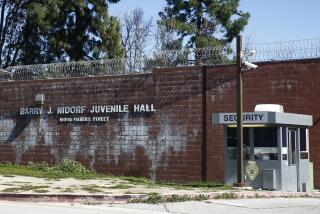Keeping kids out of detention facilities works
- Share via
TACOMA, WASH. — A steady decade-long drop in teen offender recidivism rates here in Pierce County is not the result of reforms implemented in some other places -- building smaller, homelike facilities, adding social workers and making therapists available 24/7.
Instead, “we chose to focus on programs proven to keep kids out of state institutions -- to use dollars not on our detention facilities but in the communities,” says Shelly Maluo, administrator of the county’s juvenile court system.
For starters, the county began collecting much more precise and comprehensive data on the teen felons it had released, tracking them for two years on probation.
“Did they reoffend? If so, who was it? What is their race, gender? What is their community like? Their family? Were drugs or alcohol involved? We also look at the treatment we gave them, to see what worked, and didn’t,” Maluo says.
Another big change: After their first arrest, offenders and their families go through “risk assessment” -- a detailed interview -- to screen out those less likely to become chronic violent offenders. The high-risk kids are detained, schooled and given therapy to help them control anger and make decisions based on reason, not impulse or peer pressure.
The rest are handled outside of the detention system.
“The research is pretty clear: The further entrenched the kids are in the system, the more dependent they become on it -- and the harder it is to keep them from developing a criminal lifestyle,” said Pam Isakson, a probation officer and supervisor for 27 years.
These lesser offenders and their parents sign agreements that obligate the children to pay fines and restitution, stay away from their victims and attend school and counseling. Community accountability boards staffed by local volunteers -- adults and teens -- make sure they comply.
And comply they do: 94% of these kids successfully complete the six-month program; 70% of them are not arrested again, county statistics show.
Other low-cost programs with high impact:
* “Alternative detention,” an all-day curriculum on Saturdays and Sundays that shows kids the benefits of long-term thinking, teamwork, and anger management.
* Weekday “evening reporting centers” -- group-therapy sessions led by social workers from nonprofit community agencies that keep kids off the streets after school lets out -- which is when teen crime spikes in Tacoma.
* Work crew, in which groups of teens power-wash sidewalks, paint over graffiti, landscape parks, do yardwork for seniors, make toys for hospitals, and restock food banks.
As its number of reoffenders declines, Pierce County has been able to cut the caseloads of its probation officers. With fewer court appearances to make, the officers can get out into communities and inspire, not just punish, teenagers.
“In the old days, you didn’t understand why the kid was where he was in life,” says Kevin Williams, who supervises a field unit of 14 probation officers. “But when you see these kids in their home environments, you understand what’s driving their decisions. That makes all the difference in the world.”
More to Read
Sign up for Essential California
The most important California stories and recommendations in your inbox every morning.
You may occasionally receive promotional content from the Los Angeles Times.












